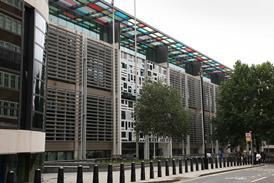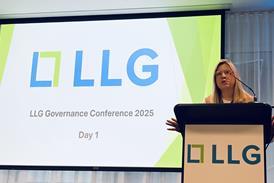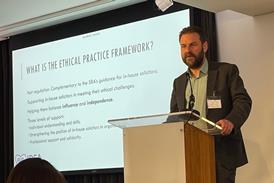District Judge Peter Jolly looks at cost benefit analyses and the importance of caps and estimates
The Civil Procedure Rules 1998 (CPR) have brought greater transparency.
Cost benefit analyses can only properly be made as to settlement if there is adequate knowledge of the likelihood of success and the cost of failure.
Caps and cost estimates can both play their part in achieving this, and may affect the areas of dispute in detailed assessments.
Look at the CPR costs practice direction section 6.
An 'estimate of costs':
- Covers only costs intended to be recovered if successful;
- Specifies those already incurred, and to be incurred;
- Includes disbursements;
- Excludes any additional liability, as defined in rule 43.2 (1) (o), and;
- Should be substantially as precedent H annexed to the practice direction (paragraph 6.5).
Paragraph 6.4 of the practice direction says that in every case outside the small-claims track scope, a costs estimate must be filed with the allocation questionnaire and served on the opponent and the solicitor's own client.
Be prepared for the district judge to refuse to allocate until compliance.
Likewise, in all fast and multi-track cases (and all bar the simplest assessments of damages are allocated), the pre-trial checklist (listing questionnaire) must be accompanied by a costs estimate.
There is an exemption for litigants in person.
Failure to comply may mean an otherwise unnecessary listing hearing, with costs consequences.
At any stage, the court can order estimates.
Cost levels inform the district judge in his evaluation of potential case management directions.
Estimates can show the likely effects of giving, or not giving, a particular direction (say for a split trial or trial of a preliminary issue).
In balancing whether to give such a direction, the court wants to know the extra costs involved, as well as, for example, the timetabling implications.
What about an application for expert evidence in a specific discipline? If a party is seeking such a direction his solicitor should prepare an estimate to show its effects.
The more costs neutral the impact of the order, the more likely it is that the party will obtain it.
But how accurate does the estimate need to be? Will the back-of-the-envelope job come back to haunt its provider on assessment, or might there be what amounts to an instant punishment with the judge granting the order while limiting the costs relating to its implementation?
Paragraph 6.6 provides that on assessment of a party's costs, the court may have regard to any estimate previously filed by that, or any other, party.
The estimates may be taken into account as a factor, among others, when assessing the reasonableness of costs claimed.
Last December, the Court of Appeal in Leigh v Michelin Tyre plc [2003] EWCA Civ 1766, [2003] All ER (D) 144 Dec drew adverse comparisons between estimates and the final bill.
An estimate is a tool to inform the court and all parties.
A costs cap is a prospective limitation.
Group litigation capping was explored in Solutia UK Ltd v Griffiths [2001] EWCA Civ 736, [2001] CPLR 419.
The analysis of Sir Christopher Staughton, in the context of instructing London solicitors, led him to conclude that '...
surely case management powers will allow a judge in the future to exercise the power of limiting costs, either directly, or indirectly, so that they are proportionate to the amount involved'.
In AB v Leeds Teaching Hospitals NHS Trust [2003] EWHC 1034(QB) - again in case management of group litigation - Mr Justice Gage, after obtaining estimates, used section 51(1) of the Supreme Court Act 1981 (which applies in all first-instance courts) to impose a budget on the claimant's publicly funded costs.
This acted as a guide on proportionality, and to provide a provisional cap.
Last November, in Smart v East Cheshire NHS Trust [2003] EWHC 2806 (QB), [2003] Lawtel, the same judge, while confirming the jurisdiction to cap costs outside group litigation, doubted the value of caps in the ordinary run of actions.
In such, he said there would rarely be a real and substantial risk that, absent such order, costs would be disproportionately or unreasonably incurred.
Costs control could be managed by conventional case management and costs assessment at the end of any trial.
This is the retrospective analysis discussed in Leigh.
But anyone involved in a costs-capping application should consider the observations of Mr Justice Gage in Smart.
There should be evidence, estimates, a short hearing, and the benefit of any doubt should lie on the party being capped, imposing what amounts to a provisional cap only.
The decision in Leigh followed a fortnight after Smart.
In Leigh the claimant's allocation questionnaire estimated costs to date at 3,000, and overall profit costs double that.
The litigation settled, and the bill amounted to 14,500 profit costs.
The total bill was knocked down marginally, with no reduction to reflect the inadequate estimate.
The Court of Appeal accepted the costs estimate was hopelessly low, and the lack of explanation for the gulf between it and the final bill.
But, as the defendant's own estimate predicted double the chargeable hours, it was not misled.
Often there will be unforeseeable additional work reflected in the final bill to explain the difference.
But the message is that greater care needs to be taken in the preparation of estimates.
Application of paragraph 6.6 may not be the most sophisticated means of costs control.
But, as Lord Justice Dyson said: 'Estimates made by solicitors of the overall likely costs of the litigation should usually provide a useful yardstick by which the reasonableness of the costs finally claimed may be measured.
Thus, if (a) the paying party did not rely on the estimate in any way, (b) the court concludes that, even if the estimate had been close to the figure ultimately claimed, its case management directions would not have been affected, and (c) the costs claimed are otherwise reasonable and proportionate, then....
it would be wrong to reduce the costs claimed simply because they exceed the amount of the estimate.'
So, why not take the initiative? Serve voluntary costs estimates - not only on making a part 36 offer or paying into court - but also regularly as the case progresses.
This may induce the opponent to settle.
And, absent agreement on costs, it remains easier to justify them when the opponent has consistently been kept informed.
Equally, a party serving inaccurate costs estimates may find it difficult to show his claimed costs are reasonable and proportionate.
But watch out for potential rule changes.
Formal budgets and tightening of the provisions on estimates are on the agenda.
District Judge Peter Jolly sits at Portsmouth Combined Court



























No comments yet